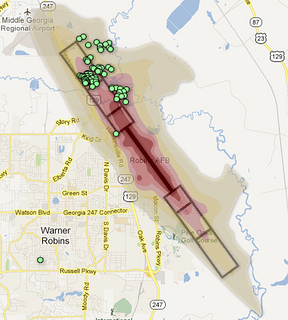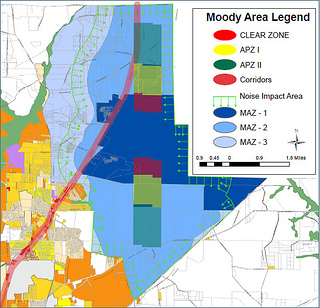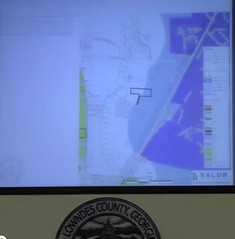Lowndes County is not “the only community in the country with a MAZ”: Houston County has very similar zones of encroachment protection around Warner Robins Air Force Base (RAFB).
As we’ve already seen, Houston County is buying up houses around RAFB using $7.5 million from the state of Georgia. That’s in addition to $6 million from Bibb County and some unspecified amount from the Defense Department. Plus Houston County allocated $7 million from SPLOST funds, and their SPLOST won by a landslide, apparently partly for that reason.
But what are
 those encroachment zones around Warner Robins AFB
depicted on the buyback map?
I called Houston County to find out.
Their Community Planner, Jacob Cox, said yes, Houston County
has crash zones, and noise attenuation zones in which they can
have businesses but not residences.
those encroachment zones around Warner Robins AFB
depicted on the buyback map?
I called Houston County to find out.
Their Community Planner, Jacob Cox, said yes, Houston County
has crash zones, and noise attenuation zones in which they can
have businesses but not residences.
He pointed me to The Robins Air Force Base and Middle Georgia 2004 Joint Land Use Study, which notes:
The 2004 JLUS examines land issues as they relate to RAFB flying missions and suggests measures to ensure compatible land use in the Base environs now and into the future. The 2004 JLUS process utilizes information provided in the 1998 RAFB Air Installation Compatibility Use Zone study (AICUZ) to evaluate land use compatibility and regulatory adequacy in areas subject to air hazard potential and noise impact. Additional considerations related to air navigation, including air protection surfaces are examined. Clear Zones and Accident Potential Zones are all considered compatible with AICUZ guidelines. Incidences of incompatible development are predominantly restricted to a limited number of non-noise attenuated residences built prior to 1994.
The results of the 2004 JLUS demonstrate that previously adopted land use regulations have been effective in limiting incompatible development within the Base environs. The 1994 adoption of the Base Environs Zoning District (BEZD) model by the surrounding communities has served to check most encroachment-type development. Only a very low number of sporadic, isolated examples of noise-related incompatible development was observed to have been built since implementation of the BEZD land regulation strategy. Consistent local government implementation of adopted provisions must be maintained in order to continue to provide the protection necessary to prevent incompatible development from restraining Base operations in the future.
So as far back as 1994 the communities around RAFB were using zoning to limit base encroachment. The 1998 AICUZ recommended further Clear Zones and Accident Potential Zones. Why? Mission changes at RAFB. So the 2004 JLUS made recommendations and the local governments, including Houston County, decided to go ahead and do something about it.
In achieving the goals and objectives of the 2004 JLUS, specific recommendations have been developed for participants. These recommendations are designed to augment and strengthen existing procedures and existing land use regulations. Each participating local government has initiated the process for adopting necessary recommended modifications, into their existing land use planning policies and regulatory procedures including noise-related parameter changes presented in the 1998 AICUZ study. The decision by Middle Georgia local governments to proactively adopt a Comprehensive Mission Noise Contour strategy will insure optimum protection for citizens in the vicinity of RAFB while continuing to allow the Air Force the greatest amount of mission planning flexibility.
That JLUS defines Clear Zones (CZ) as 3,000 feet by 3,000 feet squares at each end of the runway, Accident Potential Zones (APZ) I and II as somewhat larger rectangles, with APZ I “beyond and contiguous to each CZ” and APZ II “beyond and contiguous to each APZ I”. Plus Noise Contour Zones, as:
Defined, contiguous, curvilinear areas emanating outward from the runway at prescribed average weighted loudness intervals. The designated loudness increment level is DNL 5. The employed range of contours is from DNL 65 to DNL 85.
The RAFB JLUS spells out numerous detailed recommendations for what land uses to allow and what to deny inside each of those zones.
 Do these various zones sound familiar?
Lowndes County’s Comprehensive Plan and ULDC also have
square Clear Zones and rectangular APZ I and APZ II.
Lowndes County’s nested curvilinear MAZ-1, MAZ-2, and MAZ-3
are the equivalent of Houston County’s three Noise Countour Zones.
(And there is a
Moody JLUS, too.)
Do these various zones sound familiar?
Lowndes County’s Comprehensive Plan and ULDC also have
square Clear Zones and rectangular APZ I and APZ II.
Lowndes County’s nested curvilinear MAZ-1, MAZ-2, and MAZ-3
are the equivalent of Houston County’s three Noise Countour Zones.
(And there is a
Moody JLUS, too.)
Maps of the RAFB zones are referred to but unfortunately missing from the 2004 JLUS. However, you can see them in the Telegraph interactive map of the housing buyback. Which is something Lowndes County does not have: a zoomable google map of the MAZs overlayable with satellite imagery.
The RAFB zones are included in Houston County’s Comprehensive Plan along with numerous land use code details at least partly derived from the 2004 RAFB JLUS; see Robins Air Force Base Environs Character Area.
So it appears Commissioner Raines was misinformed:
I was recently informed that Lowndes County is the only community in the country with a MAZ, which means we have gone to greater lengths than any other community to protect against encroachment. Making minor adjustments is necessary with all ordinances and, even if the proposed changes are made, we still have the only MAZ in the country.
Lowndes County does not have the only MAZ in the country: Houston County has the exact equivalent. And Houston County has gone to greater lengths than Lowndes County in protecting its base against encroachment, in finding and allocating federal, state, and local tax money to buying up houses within the encroachment zones.
 And Houston County is buying up houses in their outer encroachment zone,
the equivalent of MAZ-III,
while
Lowndes County is considering rezoning and modifying the zoning code
for a proposed new subdivision
in MAZ-II and MAZ-III.
Houston County is actively working on fixing its problem,
while the Lowndes County Commission proposes to make our problem worse.
And Houston County is buying up houses in their outer encroachment zone,
the equivalent of MAZ-III,
while
Lowndes County is considering rezoning and modifying the zoning code
for a proposed new subdivision
in MAZ-II and MAZ-III.
Houston County is actively working on fixing its problem,
while the Lowndes County Commission proposes to make our problem worse.
Is Lowndes County really less concerned about its largest employer than Houston County is about its equivalent? Maybe if enough people call or write their Lowndes County Commissioners the Commission will make the wise decision Tuesday: table or deny that text amendment, and deny that rezoning.
-jsq
Short Link:
I came across your blog entry now and I am surely surprised in a good way by the way you make your posts! How exactly do you inform your readers about the fact that you added a post to your portal?